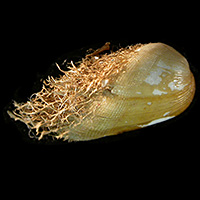|
< Previous family introduction |
|
|||||
 |
Family Mytilidae Mussels
|
|||||
|
The Mytilidae is a worldwide family of bivalves. In common with other bivalves, mussels feed by filtering minute animals and plants as well as particles of organic matter from the seawater as it passes over their gills. Mussels live attached to the substrate by a byssus, which is a tuft or clump of hairs secreted by a gland on the animal’s foot. Some species produce a felt-like mass of byssal fibres around themselves and live within it for protection. Some species are gregarious, sometimes forming dense monospecific aggregations on intertidal shores, both on the open coast and in estuaries. Mussels are common on man-made structures such as wharves and jetty piles at the appropriate tidal level. The common species live intertidally, but there are a few species that occur only subtidally; one NSW species is found in water as deep as 1000 m. There are less common solitary species which live subtidally attached to stones or within clumps of sponges or ascidians. The Blue Mussel, Mytilus sp., is farmed commercially for food in NSW. They are grown on ropes suspended below buoys or rafts. Most of the NSW mussels follow the usual molluscan distributional pattern of occurring from southern Queensland, southwards and around southern Australia, to south-western Western Australia, including Tasmania. However, two species are considered to occur in New Zealand as well as Australia, although there have been no rigorous studies to decide if the Australian and New Zealand populations are really the same species. A few mussels are invasive species globally. The Asian Bag Mussel, Arcuatula senhousia, is native to the north-west Pacific Ocean but has been introduced accidentally to North America, New Zealand and southern Australia, and is now well established there. It occurs across southern Australia from Victoria to south-western WA but has not been reported from NSW, although NSW estuaries appear to be a suitable habitat for it. An earlier introduction to Australia was the European Blue Mussel, Mytilus galloprovincialis, which has hybridised with the endemic species Mytilus planulatus so that most populations of Mytilus in Australia are now hybrids. Family References Laseron, C. 1956. New South Wales Mussels. A taxonomic review of the family Mytilidae from the Peronian zoogeographical province. The Australian Zoologist 12: 263?283. Coverage All the named NSW mussels are listed here. Additional species Exosiperna relata Iredale 1929 (Date erroneously given as 1919 by Lamprell & Healy) This species is known only from the type specimens, from 22 miles (35 km) off Narrabeen, collected in 1906. It was figured by Lamprell and Healy (1998, species 208). It is most likely a specimen of Exosiperna scapha (Verco, 1908), which occurs in southern Australia from Victoria to Western Australia. However, no formal synonymy is made here. Leiosolenus simplex (Iredale, 1939) This species is known from northern WA, around northern Australia, to northern NSW. The only NSW specimens held in the Australian Museum collection are from Solitary Islands, NSW, taken by a diver at 10 m depth. Lithophaga teres (Philippi, 1846) This species is known from southern WA, around northern Australia to northern NSW. A NSW record is held in the Northern Territory Museum, from Split Solitary Island, just north of Coffs Harbour. Modiolatus victoriae (Pritchard and Gatleff, 1903) This species was listed in Iredale & McMichael’s (1962) checklist as recorded from Twofold Bay, NSW, but neither those specimens nor any others from NSW could be found in the Australian Museum collection.
|